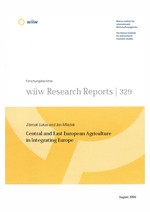Central and East European Agriculture in Integrating Europe
Zdenek Lukas and Jan Mládek
wiiw Research Report No. 329, August 2006
40 pages including 13 Tables and 8 Figures
After the EU enlargement of May 2004, the exchange of agro-food goods between the EU 15 and the new member states (NMS) has accelerated considerably. In particular the expansion of Polish exports in 2005 resulted in the highest surplus registered by the NMS 4 (Czech Republic, Hungary, Poland, Slovakia) in the past decade. Lower production costs in agriculture, especially for labour, are a fundamental cause of Poland's success to date. Despite remaining net importers, the Czech Republic and Slovakia have also slightly improved their position on the EU agro-food markets. Hungary's great ambitions - prior to EU accession - to further expand to EU markets have so far not materialized. The Hungarian setback is rooted in higher production costs, in particular in the livestock sector, and delayed preparations needed to meet European standards. Backed mostly by direct payments and by high EU internal farmgate prices for a number of products, the economic situation in agriculture in the NMS-4 has improved substantially after accession to the EU.
In the years to come, price competitiveness in the NMS will erode as the slight deterioration in agricultural terms of trade visible in the past decade will continue. With ongoing integration into the EU, labour costs and land prices will be on the rise, while farmgate prices in the EU, under pressure from the WTO, will drop in the long run. Further liberalization of the agro-food markets and rising labour productivity will result in a reduction of agricultural jobs in the EU. Consequently, the production of organic foodstuffs and other labour-intensive regional specialties may become an increasingly attractive option to survive. The size and structure of farms will vary between countries depending on the different natural and climatic conditions, as well as their previous histories. It can be expected that large market-oriented farms will continue to constitute the majority in the Czech Republic and Slovakia and, to a lesser extent, in Hungary; the significance of smaller market-oriented farms is likely to dwindle. In Poland, this concentration process will ensue at a much slower pace owing to the country's completely different post-war development. Mounting WTO pressure and the growing reluctance of rich EU member states to contribute to the Brussels budget for the development of poorer countries of the Union will lead to a weakening of redistribution processes. As a result, the total amount of money available from Brussels for redistribution under the CAP will be less than today.
Keywords: Central and East European new EU member states, agriculture, food industry, agro food trade, EU integration, regional development, Common Agricultural Policy, WTO
JEL classification: F15, H71, J33, J43, O13, O57, P32, Q14, Q15, Q17
Countries covered: Austria, Czechia, Hungary, Poland, Slovakia, Visegrad countries
Research Areas: Macroeconomic Analysis and Policy, International Trade, Competitiveness and FDI, Regional Development, Sectoral studies
